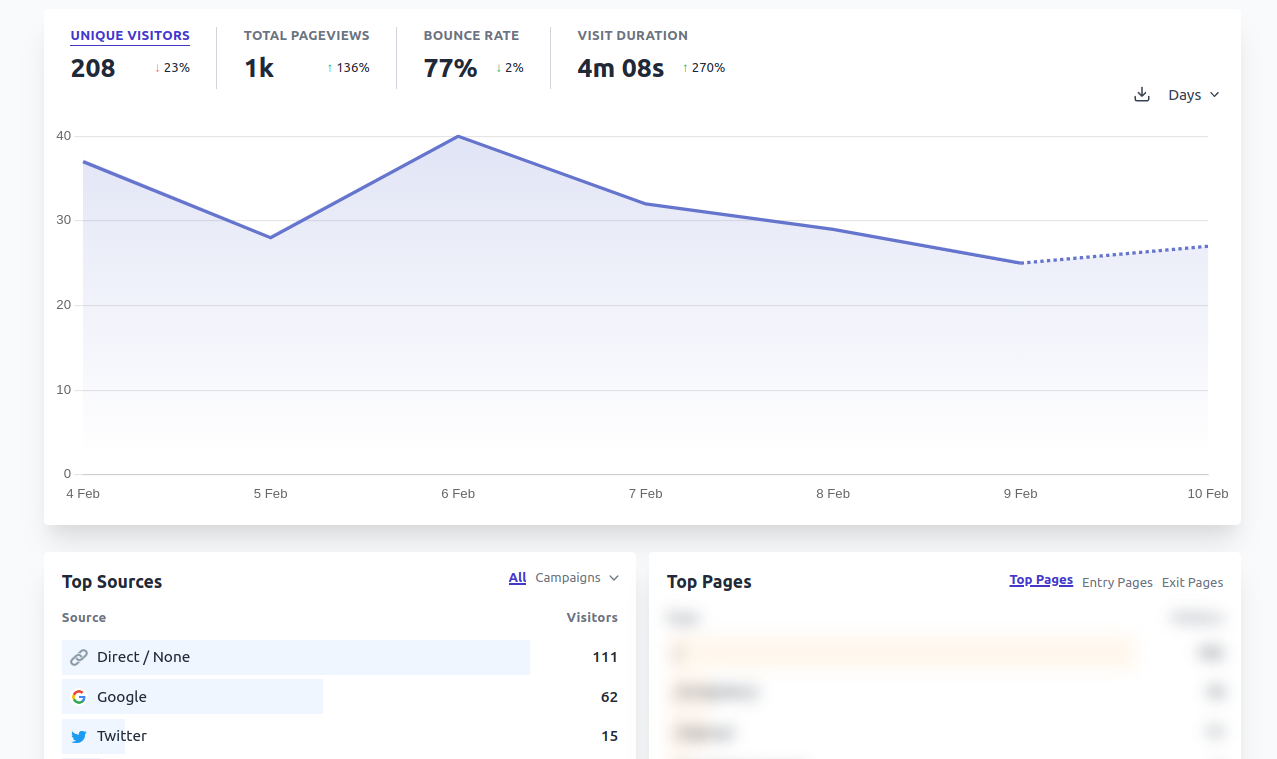The time has come. The end is nigh.
Google is officially sun setting Universal Analytics (UA) this year, and I'm tired of getting emails about it.
Over the past year, I've seen a lot more discussion and praise for alternative analytics services. Most of them are paid, with an emphasis on privacy and GDPR compliance (meaning no popups for users to opt-in or accept cookies).
Three front runners seem to get more mention than the rest. And a couple of weeks ago, I tried to throw them all onto a single website (one that I'm still developing and don't care a ton about) to see if one service might emerge as the best.
But wait, what's wrong with GA4?
For me, the biggest problem with the new iteration of Google Analytics (GA4), is the changes made to acquisition metrics.
Increasing traffic (the ultimate goal for every site, right?) starts with analyzing user acquisition. I want to know where or how people are finding out about my sites. And when I see something that works, I double down on it. Then rinse, repeat, and profit! (hopefully)
Google committed a cardinal sin when they removed the "full referrer" path from GA4. The layout is annoying, but I could get over it. So long as I had access to all the data in UA.
While GA4 does include referring domains, it does not include the full path of the referring page. For example, if you suddenly get a bunch of traffic from Reddit, GA4 will only tell you that your traffic is coming from somewhere on Reddit. But it won't give you the URL to the actual page with the link people are clicking.
There are other, smaller things I dislike about GA4. But this was the issue that made me decide alternative services were worth exploring.
Simple Analytics

Simple Analytics (SA) was the most privacy focused option I explored. It uses the user's "referrer" header to determine whether a visitor is "unique", instead of their IP address.
At first, I was a little miffed by this. The referrer method has no means for determining if a visit is truly unique. It simply counts each time someone enters your site. So, even if someone visited 20 minutes ago, if they don't use an internal link, that page view will count as a unique visit.
Having used Google Analytics (GA) for so long, I expected some means for tracking the number of individual people using my site, not just the number of visits (or sessions) the site receives in general.
But after some thought, I began to wonder if I really needed to track "unique visitors" in the first place.
Are sessions actually a better metric for my goals?
I monetize my programmatic site through display ads. Does it really matter how many "unique" people I get on the site if users are constantly being served unique ads? Plus, with so much traffic coming from search, I think it's fair to assume that a majority of visitors are indeed unique.
For my two micro-SaaS though, it's a slightly different story. My ultimate goal is to get lots of returning visitors, because this means people are using the service. It's imperative I know what percentage of visitors are new leads and where they're coming from, versus returning visitors using the app.
These two audiences need to be analyzed separately for a SaaS website. And I'm not sure how I might do that in SA currently.
A Slight Twist
TL;DR: For the purposes of this evaluation, I didn't use SA on the same site that I used Fathom and Plausible.
Next I headed over to Plausible to see how it compared to SA. While SA reported 80 visitors for this site in the past two weeks, Plausible only reported...5?!
I jumped over to Fathom, and was surprised to see the same thing. Only 5 visitors reported for the past two weeks.
Something clearly wasn't right here. Since SA had recorded so many unique countries of origin, I figured it's traffic must have some validity. Surely, in the past couple of weeks, this site hadn't received traffic from only 5 different people.
I opened up the developer tools on my browser and noticed Wordpress was overwriting the URLs for each service's script, in order to serve its own cached version. Clearly suspect, I headed to the Plausible documentation looking for answers. Right away, I found this paragraph:
On WordPress? We recommend you use our plugin. It's very lightweight, excludes admin visits by default and allows you to see the stats in your WP dashboard. It also avoids conflicts with WP Rocket and similar plugins that can happen with our snippet. See more here.
Until recently, I avoided Wordpress. So I was unfamiliar with these plugins and their...features. When presented with each script tag, I simply added it to the site's header (using a plugin since that was easiest), and washed my hands of it. I don't recall seeing any tips about Wordpress when initially presented with the script in Plausible or Fathom. Though, turns out, they both have special sections for Wordpress in their documentation.
This fiasco was definitely user error on my part. However, I think both services could do a little more to guide users and avoid these problems. Perhaps pointing people towards their integrations before presenting them with the script? Not that I probably would have paid attention anyway. 😅
Luckily, I had a hunch these two services might be winners. So I added them both to another site when I set up this experiment.
Plausible

Plausible is the service I've seen praised the most in my circles lately. It's entirely open source. So, if you're looking for a completely free alternative to Google Analytics, hosting a plausible instance on your own server is likely your best bet.
Convenience is more important to me right now, so I opted for the "done for you" paid version.
I wouldn't consider myself an analytics "power user." I mostly care about basic things like overall traffic, bounce rate, and where people are coming from. Plausible does a great job making the metrics I care most about obvious and available right out of the box. The UI was very enjoyable and easy to use.
I also love that they include the user's entry and exit pages as part of their metrics, which was missing in SA.
Where SA puts focus on tracking custom goals and events, Plausible puts UTM tracking (basically custom URL query parameters) front and center. Again, my usage of analytics is pretty simple, so I haven't played with either custom goals, events, or UTM parameters yet. But technically, both platforms support all three.
I found Plausible's method for tracking unique visitors much more reliable, since it uses the user's IP address. And this method is still GDPR compliant since the data is anonymized (so no pop-up necessary).
Compared to SA, I thought Plausible was much closer to a complete GA replacement.
Fathom

Out of the three options I tested in this experiment, Fathom is the one I've been using the longest. It was the first privacy focused, GDPR compliant service introduced to me. And as an added bonus, it's entirely independent and bootstrapped!
I initially loved Fathom because it's so simple. It uses the same hashed and salted IP system as Plausible for tracking users. And you can make things more complicated with custom events and UTM parameters (though I never felt this was necessary).
Fathom also makes it very easy to compare metrics by default. For instance, if you want to compare page views versus bounce rate, simply click on each metric in the dashboard, and both will show up on the graph.
And as an added bonus, Fathom has uptime monitoring for your site built in. It's required you turn it on first, but I thought this was a really neat touch.
That said, I used Fathom for my SaaS, PageFactory, for a few months by this point. And as my marketing efforts were getting more serious, I wondered if I was missing out on important information.
For instance, I want to start a blog for PageFactory. If a user enters the website through social media or search, how could I track their journey through my funnel?
None of the options I explored provided the kind of "Behavior Flow" metrics available in UA. However, Plausible at least provided information about the user's exit pages out of the box. At the very least, that's some information about the user's journey that I wouldn't have to set up, or dig for, on my own.
The Decision...
While Simple Analytics might be fine for niche sites that are monetized through display ads, I felt the way it tracks unique users was a little too simple to service the variety of sites I own. So, as expected, the final decision was between Plausible and Fathom.
I really wanted to fall in love with Plausible after all the good things I've heard. But, in the end, I decided to stick with Fathom.
I have to admit, I liked the UI for Plausible more. But Fathom is slightly cheaper, and it includes uptime monitoring. Both services are very similar. But for me, the price and uptime monitoring put Fathom slightly over the top.
To be fair, my analysis of these services was fairly surface level. There may be additional functionality for a service I left out, or got slightly wrong. You should always do your own research when deciding which software to use, as opposed to following the advice of a random internet stranger! But I hope this write up at least gave you an introduction to each service, and information on why you might like one over the other.
